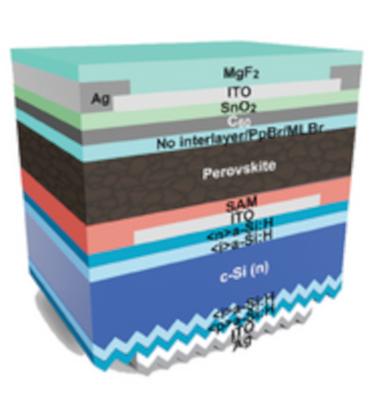An international team of researchers, including ones from the University of Sydney, IEK-5 Photovoltaics at Forschungszentrum Jülich, Southern University of Science and Technology, UNSW and the University of Ljubljana, recently reported the use of a piperidinium bromide (PpBr) as an interlayer between C60 and perovskite. The interlayer was further optimized by introducing an additional oxygen atom on the opposite side of the NH2+.
The tandem structure that the team used for demonstrations. Image credit: Advanced Energy Materials
This reportedly resulted in morpholinium bromide (MLBr) with increased dipole moment. Because of this, MLBr was highly effective in minimizing the energy band mismatch between perovskite and C60 layer for electron extraction while at the same time passivating defects.
The champion single junction 1.67 eV MLBr solar cell produced a PCE of 21.9% and the champion monolithic MLBr perovskite-Si tandem cell produced a PCE of 28.8%. Most importantly, both encapsulated MLBr and PpBr devices retained over 97% of their initial efficiency after 400 thermal cycles (between −40 and 85 °C), twice the number of cycles specified by the International Electrotechnical Commission (IEC) 61215 photovoltaic module standard.
The team demonstrated that the tuning of the dipole moment of the interlayer between the perovskite layer and C60 is effective in enhancing electron transport in wide bandgap and perovskite-silicon tandem solar cells. They did so via an appropriate choice of material such as morpholinium bromide (MLBr) which has an additional oxygen in the otherwise piperidinium bromide (PpBr) structure.
This work demonstrates an effective method of inserting the dipole layer between perovskite and C60 overcoming the instability problem that is otherwise present when LiF is used as an interlayer. In addition, MLBr is a cost-effective and accessible material that can be utilised in future efficient and stable perovskite-based multi-junction device research and development work.




